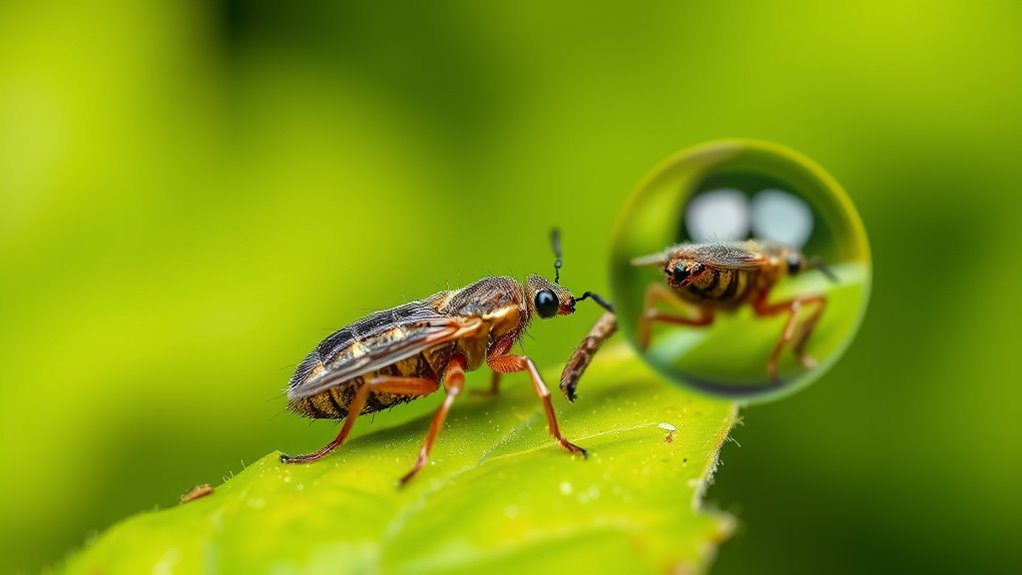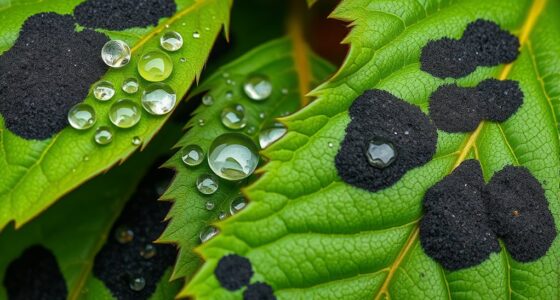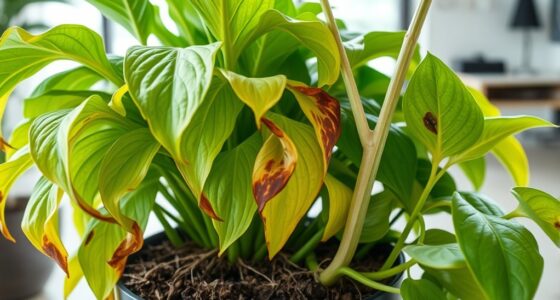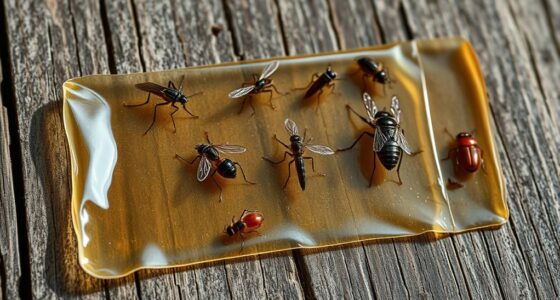Using smartphone macrophotography for pest ID is a powerful way to capture detailed images that help in accurate identification. Choose a good macro lens compatible with your device, stabilize your phone, and use proper lighting to highlight fine features. Focus carefully on key parts like wings or antennae, and consider editing apps to enhance clarity. Mastering these techniques guarantees sharp, clear photos that make pest identification faster and more reliable—if you want to learn more, keep exploring these expert tips.
Key Takeaways
- Use compatible macro lenses and stabilize your smartphone with a tripod or steady surface for sharp, detailed images.
- Ensure optimal lighting with natural or diffuse artificial sources to highlight pest features clearly.
- Adjust camera settings manually, including focus, exposure, and ISO, to capture fine details accurately.
- Focus on key distinguishing features like wing patterns, antennae, or textures for effective pest identification.
- Use image editing tools to enhance sharpness, contrast, and clarity while maintaining true pest representation.
Selecting the Right Macro Lens for Your Smartphone
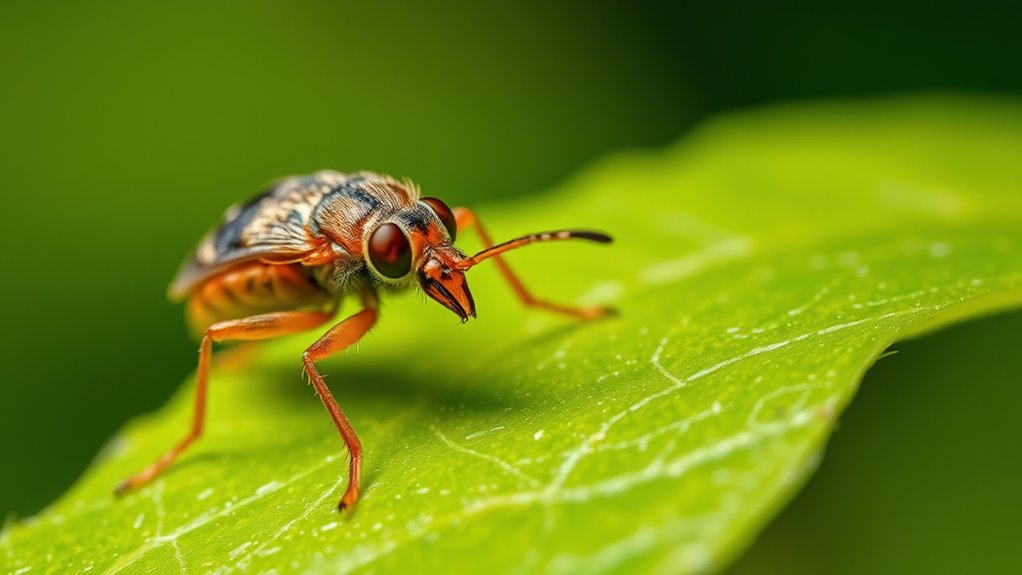
Choosing the right macro lens is essential for capturing clear, detailed images of pests with your smartphone. First, check lens compatibility with your device to ensure it fits securely and functions correctly. Many lenses are designed for specific phone models or brands, so verifying compatibility prevents frustration. Next, consider zoom capabilities; a good macro lens should offer sufficient magnification to reveal fine pest details without distortion. Look for lenses that provide a high-quality optics design to maintain sharpness and clarity at close distances. Some lenses come with adjustable zoom features, giving you flexibility when framing your shots. Optical quality is crucial in ensuring the images you capture are sharp and true to life, especially when identifying pests. By selecting a lens that pairs well with your smartphone and offers strong zoom capabilities, you’ll be better equipped to capture detailed images needed for accurate pest identification.
Preparing Your Smartphone for Macro Photography
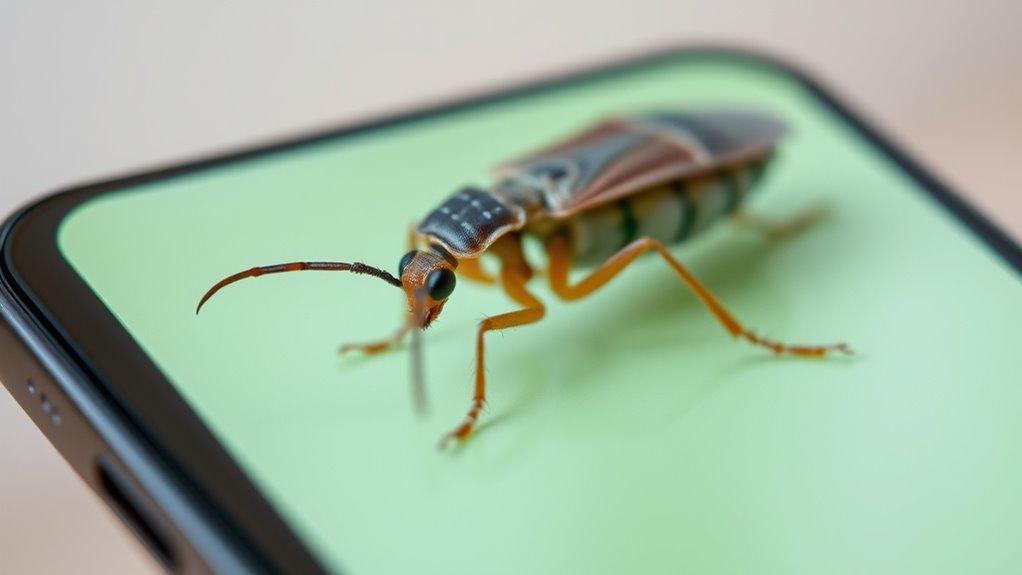
Before you start capturing close-up images, make sure your smartphone is ready. Clean your lens to avoid blurry spots, and find good lighting to highlight details. Stabilize your phone to prevent shaky shots and get sharp, clear macro photos. Maintaining privacy when sharing your images online can help protect your personal boundaries.
Clean Your Lens Properly
A clean lens is essential for sharp, detailed macro photos of pests. Poor lens hygiene can result in blurry images, making it harder to identify pests accurately. To maintain excellent camera performance, regularly clean your smartphone’s lens using a microfiber cloth or a soft, lint-free cloth. Avoid harsh cleaning agents that could damage the lens coating. Proper camera maintenance includes gentle wiping to remove fingerprints, dust, and smudges that accumulate over time. Before each macro session, inspect the lens for dirt or smudges and clean it carefully. This simple step ensures your photos are clear and detailed, allowing for better pest identification. Taking care of your lens not only improves image quality but also extends your smartphone’s camera lifespan. Regular lens cleaning is also important for maintaining optimal camera performance.
Use Adequate Lighting
Proper lighting is essential for capturing sharp, detailed macro photos of pests with your smartphone. Your lighting setup can greatly affect the clarity and quality of your images. Natural light often provides even, soft illumination that highlights details without harsh shadows, making it ideal for macro shots. If natural light isn’t available, artificial lighting such as a ring light or small LED panel can help illuminate the subject evenly. When choosing between natural vs artificial light, consider the environment and the time of day—bright, overcast days are best for natural light, while controlled artificial lighting offers consistency regardless of weather. Avoid direct sunlight that causes glare or deep shadows, and aim for diffuse, balanced lighting to reveal the finest pest details. Incorporating advanced AI technology can further enhance image clarity and assist in pest identification.
Stabilize Your Phone
To capture sharp, detailed macro images of pests, keeping your smartphone steady is key. Using a tripod support helps eliminate hand shake and provides stability during shots. Even resting your phone on a stable surface can make a big difference. Before shooting, check your camera settings—adjust focus, exposure, and ISO for ideal clarity. Use manual mode if available to fine-tune these settings, ensuring your images are crisp and well-lit. Avoid rushing; hold your phone still and take multiple shots if needed. Proper stabilization prevents blurriness and highlights intricate pest details. Remember, a steady phone combined with the right camera settings leads to clearer, more professional-looking macro photos, essential for accurate pest identification. Additionally, understanding headphone compatibility can improve your audio experience when reviewing your images or tutorials.
Tips for Achieving Sharp and Clear Pest Images
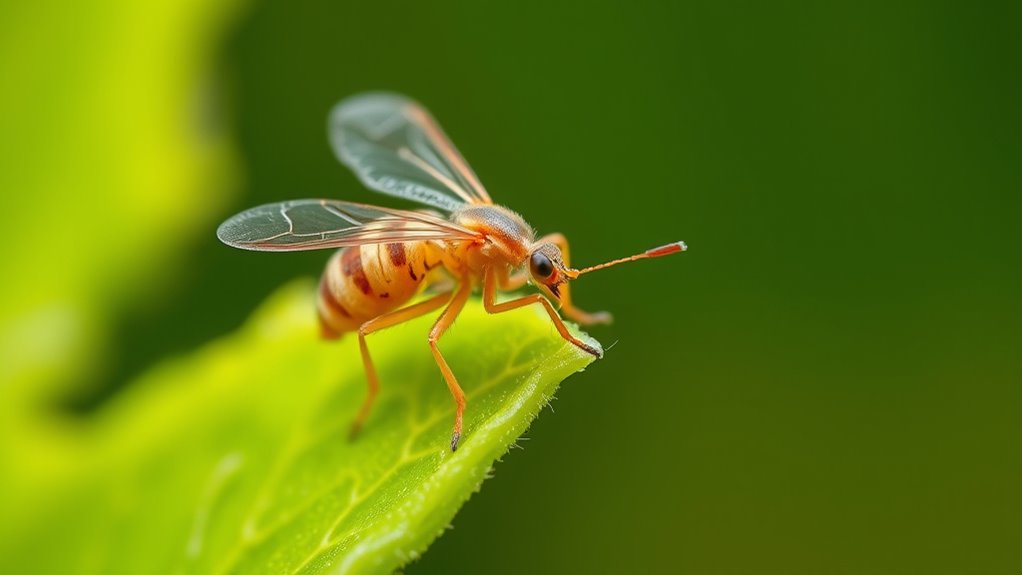
To get sharp and clear pest images, focus on keeping your hand steady during each shot. Using ideal lighting conditions, like natural sunlight or a bright, diffuse light source, helps reveal fine details. Combining stable positioning with good lighting makes your macro photos much clearer and more detailed. Additionally, understanding industry trends can help you select the best equipment and techniques for high-quality pest photography.
Steady Hand Techniques
Holding your smartphone steady is essential for capturing sharp, detailed images of pests. To improve stability, brace your elbows against your body or a stable surface. Keep your hand movements minimal to avoid blur. For consistent results, maintain angle consistency so your shots stay uniform, and focus on controlling the depth of field to keep the pest in sharp detail. Consider using a tripod or stabilizer if available. Remember, small adjustments in angle can affect clarity, so move slowly and deliberately. Keeping these techniques in mind ensures your images are clear and precise, making pest identification easier. Additionally, understanding camera stabilization techniques can further enhance your image quality.
- Use your body as a stabilizer
- Maintain consistent angle and distance
- Limit hand movements
- Focus on controlling depth of field
- Adjust posture for maximum stability
Optimal Lighting Conditions
Good lighting makes a significant difference in capturing sharp, detailed images of pests. For the best results, use natural light whenever possible, such as near a window or outdoors, to enhance color accuracy and detail. When natural light isn’t available, artificial lighting like LED or ring lights can help eliminate shadows and improve clarity. Avoid harsh, direct light that causes glare or overexposure. Instead, opt for diffused lighting for even illumination. Here’s a quick comparison:
| Natural Light | Artificial Lighting |
|---|---|
| Soft, even, and true-to-life colors | Controlled, adjustable brightness |
| Best outdoors or near windows | Ideal indoors or in low light |
| Use time of day for optimal light | Use diffusers or reflectors |
Balancing these lighting options will give you sharp, clear pest images every time.
Lighting Techniques to Enhance Detail and Reduce Shadows

Proper lighting is essential for capturing clear, detailed images in smartphone macrophotography, especially when identifying pests. To enhance detail and minimize shadows, focus on using diffuse lighting. This softens harsh shadows and evenly illuminates the subject. Techniques for achieving this include using a light diffuser, shooting near natural light, or bouncing light off a reflective surface. Utilizing smart controls can also help fine-tune exposure and brightness for optimal results.
Diffuse lighting softens shadows and evenly illuminates pests for clearer smartphone macro images.
Key tips include:
- Use a softbox or diffuser for even light
- Position your light source at an angle to avoid direct glare
- Employ reflectors to bounce light into shaded areas
- Opt for natural over harsh artificial lighting
- Adjust your angle to reduce shadow prominence
These methods help you achieve shadow reduction and highlight fine details vital for accurate pest identification.
Framing and Composition for Effective Pest Identification
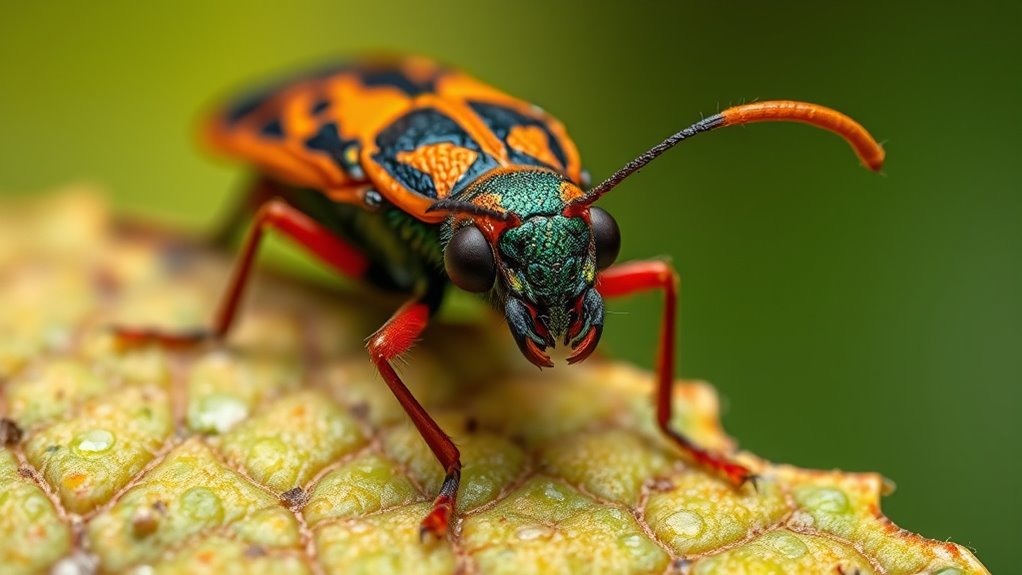
To effectively identify pests through smartphone macrophotography, mastering framing and composition is essential. Focus on establishing strong focal points by centering the pest or highlighting distinctive features. Use framing techniques like the rule of thirds to create balanced, engaging images that draw attention to key details. Ensure the pest fills the frame without excessive background distraction, which can obscure important features. Keep your camera steady to avoid blurry images, and experiment with angles that showcase the pest’s morphology. Proper framing directs the viewer’s eye to critical identification traits, making your photos more useful for analysis. Remember, clear, well-composed images save time and improve accuracy when identifying pests in the field. Incorporating high-quality anime films and understanding diverse visual styles can also help develop a keen eye for detail and composition.
Using Editing Apps to Improve Image Clarity and Detail
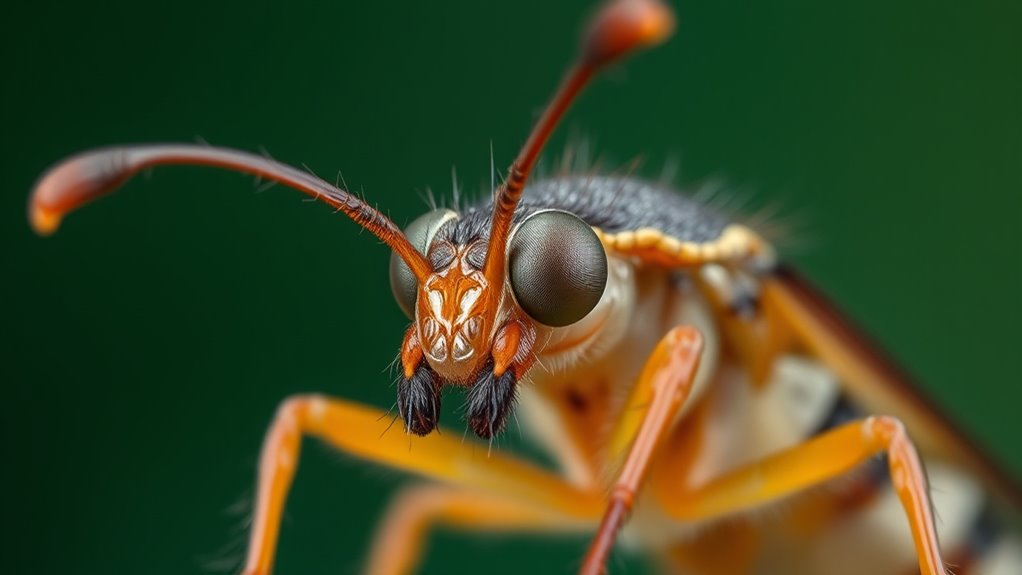
After capturing your pest photos with careful framing and composition, enhancing their clarity and detail can make a significant difference in identification accuracy. Using editing apps for image enhancement allows you to highlight key features that might be hard to see otherwise. With the right tools, you can sharpen details, adjust brightness, and improve contrast, bringing out subtle textures and patterns. This process helps you better distinguish pests from similar species. Remember, subtle edits can make a big difference without misrepresenting the image. Additionally, understanding toilet maintenance and repairs can help you identify pests that thrive in damp or clogged environments, further aiding in accurate identification.
Best Practices for Capturing Different Types of Pests
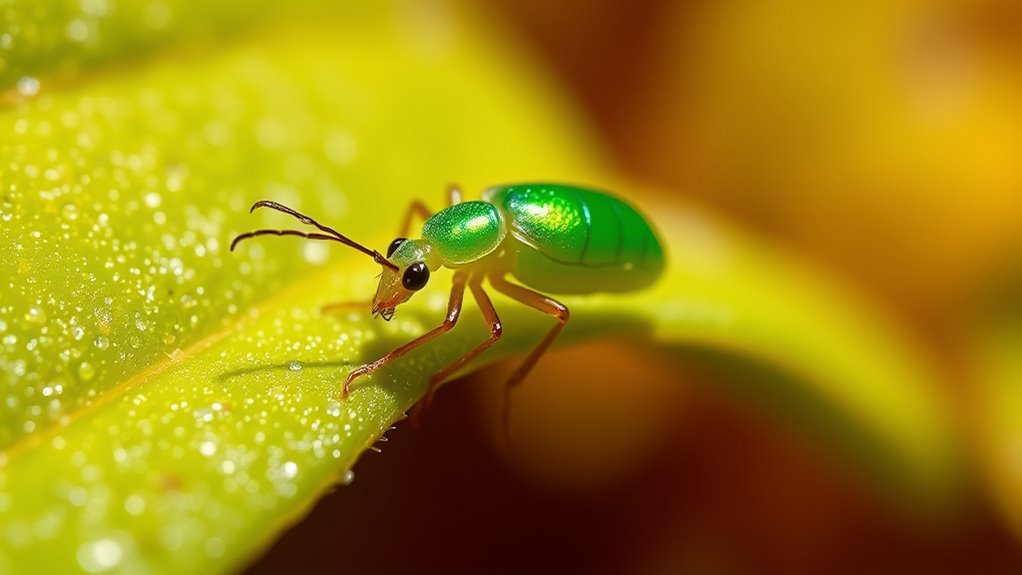
Capturing different types of pests requires adjusting your approach to suit their unique behaviors and appearances. For active pests like flying insects, stabilize your camera and focus on clear, close-up shots of their identification markers, such as wing patterns or antenna shapes. When photographing stationary pests like mites or eggs, guarantee good lighting to highlight surface textures and color variations. Understanding pest behavior helps you anticipate their movements and choose the right moment to shoot—wait for them to settle or pause. Use steady hands or a tripod, and get as close as possible without disturbing them. Focus sharply on distinguishing features, like markings or body segments, to improve identification accuracy. Tailoring your technique based on pest behavior and identification markers ensures you capture detailed, useful images.
Sharing and Utilizing Macro Photos for Pest Management and Research

Sharing and utilizing macro photos of pests can substantially enhance pest management strategies and research efforts. High-quality images help identify pest behavior, track infestation patterns, and inform control methods. When sharing photos, always respect macro photography ethics by obtaining proper permissions and avoiding manipulation that could mislead. Your images can support scientific studies or community alerts, making pest identification accessible. Consider these key points:
- Accurate representation of pest features
- Respect for privacy and property rights
- Clear documentation of pest behavior
- Collaboration with researchers and extension services
- Promoting responsible sharing to prevent misinformation
Frequently Asked Questions
How Can I Stabilize My Smartphone for Better Macro Shots?
To stabilize your smartphone for better macro shots, try using tripod alternatives like a stack of books or a steady surface. You can also improve stability by holding your phone with both hands and bracing your elbows against your body. Additionally, use good lighting techniques—natural light or a ring light—to reduce shake and enhance detail. These methods help you capture sharp, detailed macro images for pest identification.
What Environmental Conditions Are Best for Pest Macro Photography?
Great macro shots come down to the right environment. You want bright, even light conditions—natural sunlight works best when it’s diffused, avoiding harsh shadows. Choose a background with high contrast to make your pest stand out clearly. Overcast days provide soft, consistent light, while avoiding wind helps keep your subject steady. These conditions make certain your smartphone captures sharp, detailed images essential for accurate pest identification.
Can Different Smartphone Brands Impact Macro Image Quality?
Different smartphone brands can impact macro image quality due to sensor differences and image processing capabilities. Some brands feature larger sensors that capture more detail, while others excel in advanced image processing that enhances clarity and color. Your choice affects how well you can zoom in on pests, revealing tiny features. So, selecting a smartphone with a high-quality sensor and strong image processing will give you clearer, more detailed macro photos.
How Do I Identify Pests From Macro Photos if Unsure?
Imagine spotting tiny pests scuttling or feeding in your garden. To identify them, examine macro photos closely, noting pest behavior like movement or feeding patterns. Look for damage symptoms—chewed leaves, holes, or discoloration—that hint at their presence. Compare your images with trusted pest guides online or apps. If unsure, share your photos with local extension services or online communities to get expert advice and accurate identification.
Are There Specific Apps Recommended for Pest Image Analysis?
You’re wondering if there are specific pest identification apps or macro image analysis tools you should use. Many pest identification apps, like Seek by iNaturalist or Picture Insect, help you quickly identify pests from your photos. Additionally, macro image analysis tools such as Google Lens or specialized insect ID apps allow you to analyze detailed images. These tools make pest identification easier, reliable, and accessible right from your smartphone.
Conclusion
By mastering smartphone macrophotography, you can quickly identify pests like aphids or mites, saving time and resources. For example, a gardener used their phone to capture clear images of a mysterious pest, enabling expert advice that prevented a potential crop disaster. With practice and the right techniques, you’ll gain sharp, detailed photos that help you make informed decisions. Start experimenting today—your smartphone can become a powerful tool for pest management and research.
